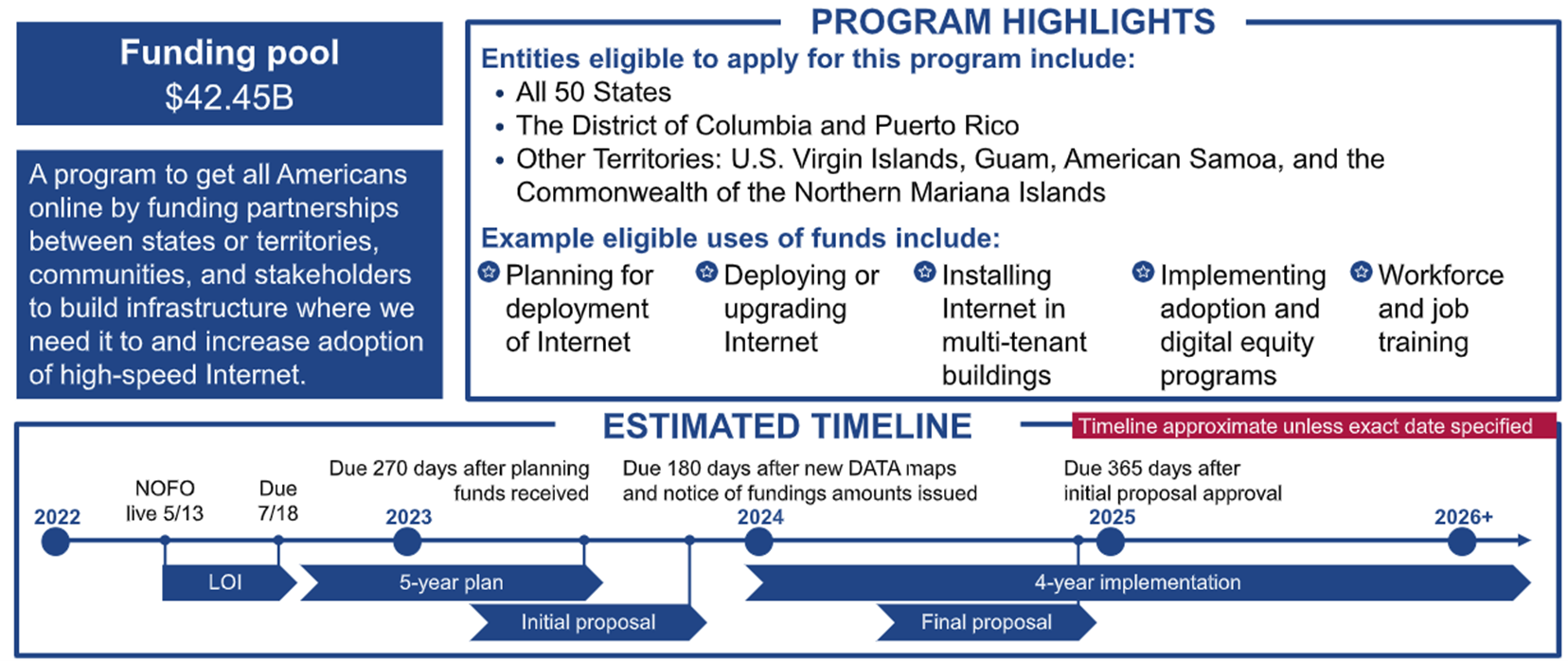The Utility’s Guide to Broadband Expansions in 2023
How the Broadband Equity, Access, and Deployment (BEAD) Program will affect Utilities
As 2022 draws to a close, utilities of all sizes should brace for an incredibly busy 2023. Massive federal grants to roll out accessible, high-speed internet will hinge on expert utility pole joint use and collaboration with communications companies. The culprit of utilities’ increased workload is the Broadband Equity, Access, and Deployment (BEAD) fund, which some estimate will increase pole attachment requests for many utilities by nearly 600%.
This post will cover facts pole owners and joint use departments need to know about BEAD funding, including broadband deployment, expected workload changes, and steps for seamlessly handling the enormous influx of attachment requests,
- What is BEAD?
- Who will receive BEAD funding?
- Which states will receive funding first?
- How will BEAD affect utilities?
- What are the major impacts and challenges to your utility’s joint use department?
- How can utilities and joint use departments prepare for BEAD?
- The premier tool for handling BEAD workloads
What is BEAD?
One of the Biden-Harris administration’s core goals is to deploy accessible, high-speed internet to unserved or underserved communities. Multiple government agencies created grant programs to subsidize broadband infrastructure expansion to execute this goal. A few of these funds are:
- The Rural Development Broadband ReConnect Program, created by the U.S. Department of Agriculture. ReConnect will provide roughly $2 billion to eligible applicants over five years.
- The Capital Projects Fund (CPF), created by the U.S. Department of the Treasury. This fund will provide $10 billion in funds over four years.
- The Rural Digital Opportunity Fund (RDOF), created by the Federal Communications Commission (FCC). RDOF will disburse $20.4 billion over ten years to eligible applicants.
However, the most significant grant program of all is BEAD. Created by the National Telecommunications and Information Administration (NTIA), BEAD aims to disburse $42.45 billion to eligible applicants over five years.
Who will receive BEAD funding?
Each state, the District of Columbia, and Puerto Rico will receive a minimum allocation of $100 million to fund broadband infrastructure projects. The U.S. Virgin Islands, Guam, American Samoa, and the Mariana Islands will receive a minimum grant of $25 million. Further allocation amounts will depend on the number of unserved locations in each state or territory. The FCC has created a broadband map of the continental U.S. and its territories to outline communities needing high-speed internet.
As states and territories receive grants, telecommunications companies will develop and submit plans for increasing broadband access to their communities. States and territories will pass BEAD funding along to communications companies based on the effectiveness of the programs and how quickly they can be enacted.
Which states will receive BEAD funding first?

Several states have already received BEAD funding:
- Delaware – $5.5 million
- Georgia – $5 million
- Florida – $5 million
- Idaho – $4.9 million
- Iowa – $5 million
- Lousiana – $3 million
- Mississippi – $5 million
- Nebraska – $5.5 million
- North Carolina – $6.4 million
- North Dakota- $5 million
- Ohio – $6.5 million
- Rhode Island – $5 million
- South Dakota – $2.6 million
- Utah – $5 million
- Virginia – $5 million
The disbursements listed above are specifically “planning funds,” designed to initiate the creation of five-year infrastructure upgrade and expansion plans. States will present these plans to the NTIA in late 2023 and should be ready to implement the plans by early 2024
How will BEAD affect utilities?
Many communications companies must meet tight broadband delivery timelines to qualify for funding. While the companies could bury fiber, attaching it to utility poles will make rolling out broadband more efficient and less expensive. Thus, utilities can expect a substantial increase in third-party attachment requests, make-ready construction projects, pole transfers, and other collaborative tasks. The FCC is discussing a rule to cap attachment requests at 3,000 per utility per month to soften the blow BEAD funding will land on utilities.
What are the major impacts and challenges to your utility’s joint use department?
Given the expected surge in attachment projects due to BEAD funding, joint use departments staffed by one or two analysts will be quickly overloaded. Many utilities report that their day is being consumed with joint use work and is not allowing them to focus on other activities.
Often, utility asset data is stored in siloed spreadsheets and databases. Attachment requests, permits, rental billing, and asset records are kept in separate Excel spreadsheets, GIS repositories, or databases that require constant reconciliation and duplicate data entry. As the number of attachment requests increases, so does the risk of errors. More time is spent double-checking files and manually moving data than completing tasks.
Prioritizing activities, like inspections, make-ready, approvals, completing the work, and summarizing what needs to be done to key stakeholders is essential to having a clear plan of execution. But managing tasks becomes a job in and of itself when joint use departments must handle several hundred or several thousand attachment requests.
Completing attachment projects requires effective communication with attachers. It’s common for attachers to check in on the project statuses frequently. Without an automated notification system, joint use analysts can spend hours per day sending emails or fielding calls from attachers.
While one solution to the problems above could be hiring more joint use staff, it may already be too late. Hiring, training, and confidently depending on a new employee can take months, while some states actively seek funding applications. It also doesn’t remove the problem of inefficient, outdated methods of storing data.
How can joint use departments prepare for BEAD?
To combat and conquer the broadband tsunami, joint use departments need a centralized, streamlined system to handle all aspects of the attachment process.
- The right joint use management system must incorporate utilities’ existing data rather than starting from scratch. It should be able to seamlessly sync data with GIS programs, financial systems, NJUNS, and other systems.
- Comprehensive asset records are vital. Asset history, pole location data, pole inspection records, and audit and violation reports should be stored in one location. All data should be available within a few clicks.
- Managing tasks and activities should take no time at all. It should be easy to assign tasks and visualize workloads.
- Collaboration with attachers should be completely automated. Third parties should be able to input attachment request data and check the status of pending requests through a web portal without pole owner intervention. Once a task is completed, all involved parties should receive real-time updates without pulling away analysts from more critical work. This will hasten the permitting process, as attachers should also be notified when they need to complete assignments and which entity is “next to go.”
- The system should be completely secure. A noticeable and disturbing trend of utility hacking is on the rise. Utilities must be able to assure attachers and customers that their data is entirely safe.
Joint Use 365: The Premier Tool to Handle BEAD funding workloads
Joint Use 365 is the solution for pole owners to handle BEAD workloads. It centralizes pole management, permitting, billing, and back-office processes. Joint Use 365 integrates with Esri and NJUNS to significantly reduce your utility’s workload, human error, and risk. Its automated workflows usher your third-party attachers towards job completion and increase productivity for attachers and your joint use department.
Contact us today to learn more about Joint Use 365 or schedule a demo to see it in action.

